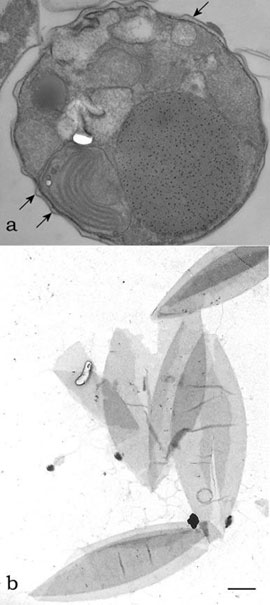Cell Wall
In the Cyanophyta the cell wall lies between the plasma membrane and the mucilaginous sheath; the fine structure of the cell wall is of Gram-negative type. The innermost layer, the electron-opaque layer or peptidoglycan layer, overlays the plasma membrane, and in most cyanobacteria its width varies between 1 and 10 nm, but can reach 200 nm in some Oscillatoria species. Regularly arranged discontinuities are present in the peptidoglycan layer of many cyanobacteria; pores are located in single rows on either side of every cross wall, and are also uniformly distributed over the cell surface. The outer membrane of the cell wall appears as a double track structure tightly connected with the peptidoglycan layer; this membrane exhibits a number of evaginations representing sites of extrusion of material from the cytoplasm through the wall into the slime. The cell wall of Prochlorophyta is comparable to that of the cyanobacteria in structure and contains muramic acid.

FIGURE 2.15 Transmission electron microscopy image of Nannochloropsis sp. in transversal section (a). Arrows point to the cell wall. Negative staining of the shed cell walls (b). (Bar: 0.5 µm.)

FIGURE 2.15 Transmission electron microscopy image of Nannochloropsis sp. in transversal section (a). Arrows point to the cell wall. Negative staining of the shed cell walls (b). (Bar: 0.5 µm.)
In the Floridophyceae (Rhodophyta) the cell wall consists of more than 70% of water-soluble sulfated galactans such as agars and carrageenans, commercially very important in food and pharmaceutical industry, for their ability to form gels. In the Phaeophyceae (Heterokontophyta) cell wall mucilagine is primarily composed of alginic acid; the salts of this acid have valuable emulsifying and stabilizing properties. In the Xanthophyceae (Heterokontophyta) the composition of the wall is mainly cellulosic, while in the Chlorophyceae (Chlorophyta) xylose, mannose, and chitin may be present in addition to cellulose. Some members of the Chlorophyceae (Chlorophyta) and Charophyceae (Chlorophyta) have calcified walls.




